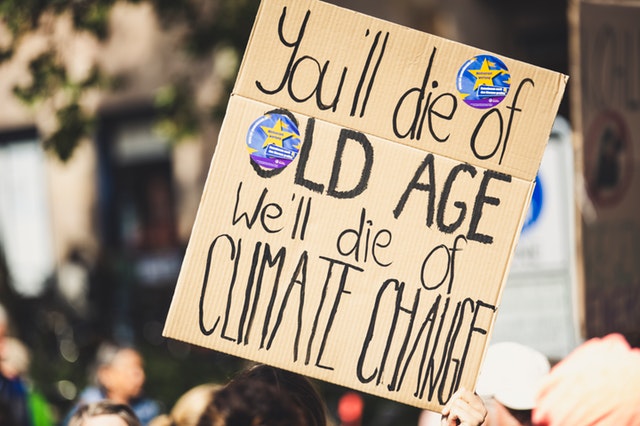
We are moving into less settled times both here and in the rest of the world. Several different storms are gathering along the waterfront today:
– in politics, with gridlock both breaking down and intensifying over impeachment and the future course for America, in the UK over its relationship with the rest of Europe and what it wants for itself, in the battles between populists and traditionalists elsewhere;
– in economics, with weakening global prosperity and the likelihood of a financial pullback that will affect almost all of us as the fundamentals weaken;
– in the environment, with increasing alarm over the current effects of global warming, the longer-term outlook for the health of the planet, and state actors’ halting efforts to respond to the challenge;
– in the world order, with a rising China, a demoralized and divided West, and a handful of nations around the edges that are both willing and able to take advantage of the uncertainty; and
– in the prevailing spirit, perhaps the most impressionistic of these storms but potentially the most powerful, as pessimism, alarm, hysteria, backlash and hostility get reduced into urgency in their boiling cauldron—a drive to do something, anything to move off the dime.
The silver lining is that chaos, confusion and uncertainty also provide opportunities. When you’re clear about the priorities behind your work, your chances to advance them are always greatest when the storms finally break as long as you’re ready to rebuild the storm-tossed world in the ways that you want. Now is the time for getting ready, because the chances to address our most pressing problems–and the rewards for us and others that can flow from that–may never be greater.
When the work we do helps us realize our priorities, it becomes more purposeful and satisfying. As I argued here last week, in many of our jobs it is both possible and desirable to align our priorities with that job’s broader objectives. Improved health. Greater fairness. A more sustainable way to live.
In other words, it’s tying what you want yourself to almost every job’s higher purposes. Not only does the alignment reduce friction between you and those impacted by your work, it can also produce an esprit de corps with your bosses, co-workers, customers, suppliers and members of the broader community as they support your efforts. You’re experiencing the shared benefits of a productive community while taking home both the pride and satisfaction that comes with it.
Of course, another essential of “good work” is its future focus: anticipating circumstances that might enable you to take bigger-than-usual strides towards realizing common priorities. It is being aware of the obstacles and opportunities today so you are ready to act when the storms break and the lay-of-the-land shifts, weakening those obstacles and providing those with a vision of the future a path for realizing it. That’s because everyone who has weathered the storm wants to put the pieces back together and is unusually receptive to putting it all back together in some better way.
Realizing your particular work ethic in times of crisis has almost nothing to do with luck but everything to do with your mindset and plans. It’s having a vision of the better future that you want, keeping your eye on that goal line as the game degenerates into chaos, and, when everyone is finally able to listen, inviting your fellow survivors to help in rebuilding something that you’re convinced will be more durable and sustainable than all of you had before. At such times, aligning your personal priorities with a higher, common purpose will not only be satisfying for you, it can also make changes that seem impossible today, possible tomorrow.
My priorities (in search of this broader resonance) would include the following:
Thriving workers, families and communities. Most of us have jobs as citizens of democratic countries with capitalist economies. We regularly make our preferences known by choosing leaders who share our priorities. As citizens during unsettled times, what kinds of change would we support and priorities would we pursue?
In large part because “thriving workers” are the foundation for other kinds of positive change (such as reducing income inequality, gaining affordable health-care and safeguarding the environment in our communities), I’ll be looking for leaders with the courage to say they are foregoing other “hot button” reforms to invest in retraining today’s workforce for a more automated world; to support trade buffers so that workers here don’t lose their jobs to cheap foreign labor when they’re compensated more fairly or work under safer conditions; and to support new public policies like bolstering the economic security of low-wage workers by supplementing their incomes through payroll deposits, thereby encouraging their continued work and improving their chances to start building wealth for their families and communities.
We don’t hear politicians making hard choices between costly alternatives. Or willing to make the engines of capitalism more democratically-driven by ensuring that working men and women have a larger seat at the table with business owners. In the wake of the economic storm that’s coming, there will be many citizen-driven opportunities to support leaders who are eager to rebuild the future on the backs of thriving workers, while admitting that to realize that goal means putting many other goals on a back burner. It should also be a bi-partisan issue. As citizens, our focus and support can help them to accomplish this one important thing as the political process bottoms out and it struggles to identify new, common goals.
Environmental stewardship. As Alain de Botton argues persuasively (and often amusingly) in The Pleasures & Sorrows of Work it can be difficult to understand the wide-ranging impacts of your paying job given the global supply chains that feed it and the distribution networks that bring your “goods or services” to consumers. Difficult yes, but hardly impossible. Among many other things, De Botton invites us to learn more about the consequences of our work, both for better and for worse. I’d argue that when we do, we’ll be able to see “how we can work better in the future” in a common light that includes “greater environmental stewardship.”
Is the product I’m selling or helping to sell, is the service I’m providing and the ways I’m providing it, improving the health of the planet or reducing it? Raising consciousness in the workplace about an issue like environmental stewardship provides opportunities for alignment with others–including bosses and even owners—who may share your concerns. The accelerating storm of today’s climate debate and the quest to find our way out of it will likely present many opportunities to change business practices (and even nudge them in groundbreaking directions) where we work.
Righting the balance between people and profits. Connecting your paid work to its wider-world impacts is not just limited to environmental stewardship. As global economies get roiled and we begin to look beyond these upheavals, we can be thinking now about how our jobs can provide greater benefits to us and our communities and not simply about how we can assist business owners in becoming profitable again. To ensure that you and I are not merely helping to restore the profit-dominated status quo after the next recession, we could be learning now how to connect our labor to “more of its fruits” than higher corporate dividends.
As I argued last March, administrators of a global education test are using that test to assess independent thinking, collaborative problem-solving and building better communities. On the theory that we “treasure what we measure,” students globally are now building these aptitudes in their classrooms because they will ultimately be tested on them.
By the same token, employers could assess (and reward) their employees–and be assessed themselves–for “aptitudes” beyond profit-making, including their success at tying company productivity to greater community benefits. For example, workers could push their companies to retain them (even with reduced hours) instead of firing them during economic downturns because policies like this maintain stable communities, or to take less profit from a product or service if it will keep a job here instead of losing it to a foreign worker. Moreover, employees who can demonstrate that they have strengthened the company-community bond would be rewarded for doing so.
The groundswell for this broader focus needs to come from forward-looking employees as well as executives and owners, and the time to be thinking about more community-oriented work assessments and broader exercises of corporate responsibility is now.
After we’ve weathered the next downturn, are looking for better ways forward and desiring greater corporate accountability for common problems—that’s when you can stand up with your new way to determine economic success.
That’s when you can argue that what’s good for the company needs to be good for the community too, and that the economic fallout might be reduced next time if the broader community were part of the equation from the start.
That’s when you can gain even more pride and satisfaction than is usually available when you help to solve common, work-related problems, because now you’re helping to humanize the foundations of democratic capitialism itself.
+ + +
We are far enough today from the economic recession that began in 2008 to gain at least a measure of historical perspective. Two new books are arguing that Barrack Obama was so eager to restore economic stability and the health of the American banking industry that he failed to “use” this crisis (as FDR had used the Depression) to seek fundamental—and to these authors—necessary changes to the country’s economic policies.
For example, in the course of re-building America’s way out of the last recession, they observe that Obama (like Clinton before him) never challenged the economic imbalance between the corporations and ordinary working people that had been a hallmark of the Democratic Party from the 1930s through the 1980s. When it came to punishing wrongdoing, Obama refused to insist that the bankers who had profited from the bubble they had created in the housing market be held accountable. When it came to economic initiatives like the Affordable Care Act, he favored market solutions over government policies and direct interventions (unlike the alphabet soup of initiatives during the Thirties or The Great Society programs of the Sixties).
According to Reed Hundt’s Crisis Wasted (out last April) and Matt Stoller’s Goliath: The 100 Year War Between Monopoly Power and Democracy (coming in mid-October), Obama sought to preserve the pro-business status quo rather than rectify the economic imbalance that disadvantaged workers, families and communities while benefiting the American business owners who held (and continue to hold) a disproportionate share of the country’s wealth.
I agree with them that a crisis is a terrible thing to waste, and that the last one was a string of opportunities neither taken nor pursued. None of us should be willing to waste the next one.
+ + +
I’m defining a “crisis” here as a ground-deep unsettling of prior certainties. A political/economic/environmental/moral crisis tends to prove that “the ways we used to do it” are no longer working and, for a brief window of attention and opportunity, regular people are willing to explore (and even support) both different and better ways forward. It’s why from the perspective of our work, we need to be ready with arguments, data, plans, hope and visions for the better world that each of us wants when that window finally opens.
We don’t need to agree on the changes. (The bold-faced objectives above just happen to be some of mine). But I’d argue that all of us need to be active parts of the conversation, even when it’s full of anxiety and has a fevered pitch. Because it’s when your work really can “change the world” and when the personal satisfactions and sense of purpose that come with it can be similarly transformative.
In 2016, a group of forward thinkers who were clustered around the University of Sussex in the UK created educational materials for anyone who is interested in seizing the opportunities of a world in flux. Those materials begin with powerful examples from history where:
– radical changes occurred in disruptive times that would not have been possible otherwise;
– to nearly everyone’s surprise, immediate changes were accepted by the public fairly rapidly; and
– longer-term improvements followed, with some expected and others exceeding expectations.
The Sussex materials also describe how, in a host of practical ways, change-agents can capitalize on the opportunities crisis presents and maintain forward momentum.
There is a broader discussion of their approach and a link to additional materials here. If you’re interested in readying yourself to take full advantage of the opportunities after our gathering storms break and the re-building begins, I think you’ll find their approach empowering.
Our work can always be aligned with deep motivations and high purposes, but the rewards are never more satisfying than when you’re helping to build a better world out of one that may be ending.
This post was adapted from my September 29, 2019 newsletter. When you subscribe, a new newsletter/post will be delivered to your inbox every Sunday morning.









